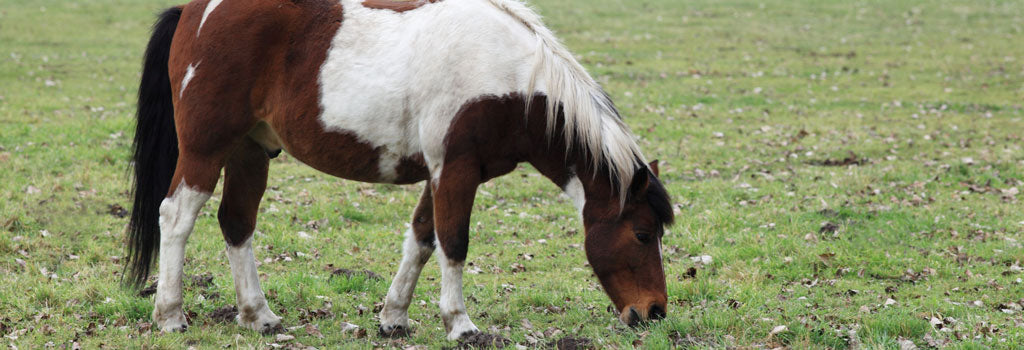PITUITARY PARS INTERMEDIA DYSFUNCTION

(EQUINE CUSHING'S DISEASE)
Pituitary pars intermedia dysfunction (PPID), a problem seen most often in older horses, is caused by tissue overgrowth in the pituitary gland. It is also known as equine Cushing's disease (ECD). Horses with PPID have high levels of adrenocorticotropic hormone (ACTH). The surplus ACTH spurs the adrenal glands to manufacture excessive cortisol, a hormone that, when off-kilter, can negatively impact numerous body systems.
The condition affects primarily middle-aged or geriatric horses, those in their late teens, twenties, or thirties, but horses as young as seven years old have been diagnosed.
Affected horses may show signs such as increased thirst and urination, loss of muscle mass, an increases susceptibility to infection, and a long hair coat that doesn’t shed normally (hypertrichosis). In addition, horses may experience changes in body weight.
These horses are at higher risk of developing laminitis and may develop cortisol-induced insulin insensitivity. PPID horses that are insulin insensitive require feeds with a low glycemic response (relatively mild increase in blood glucose and insulin following a meal). Fructan-rich pasture and grain meals may quickly lead to laminitis in horses with PPID, but these horses must still meet their requirement for basic nutrients.
Dietary and Management Considerations
Astute feeding management plays a prominent role in the treatment of PPID. Diets high in starch may increase the risk of laminitis in affected horses. Therefore, low-starch diets are typically recommended. When obesity is also a factor, low-caloric intake diets may also be required. This often poses a challenge for horse owners who are faced with providing required nutrients and limiting excess caloric intake.
Supplementation with DHA and EPA, two omega-3 fatty acids, as well as chromium has been implicated in the reversal of hyperinsulemia, or insulin resistance, in mature horses. Additionally, vitamin E and C supplementation may recharge the immune system. In particular, vitamin C levels are known to decline in aged horses, so supplementation may be helpful.
Because of the predisposition for sole abscesses and laminitis, strict attention must be paid to hoof care. All attempts to reduce the likelihood of laminitis, such as the use of a hindgut buffer and limited grazing, should be implemented.
PPID is not a death sentence. There are several management practices that can keep an affected horse in use and in good health for many years following diagnosis.
Which solution is right for your horse?
EO-3™ Omega-3 supplement. EO-3 is a rich source of omega-3 fatty acids DHA and EPA, compounds found to optimize the well-being of all horses, regardless of age or use. Specifically, DHA and EPA supplementation has been shown to mediate inflammation as well as improve insulin sensitivity. Choose EO-3 to promote a more natural balance of omega-3 to omega-6 fatty acids in the body and the benefits this balance can confer on systemic inflammatory response, immune function, and insulin sensitivity. Recommended for horses with pituitary pars intermedia dysfunction, metabolic syndrome, and any horse that is insulin resistant.
EquiShure® Time-released hindgut buffer. Developed to combat hindgut acidosis, this innovative, one-of-a-kind delivery system allows for buffering of the hindgut, the site of fermentation in the horse. Choose EquiShure to reduce the risk of hindgut acidosis escalating to laminitis in horses receiving significant intakes of starch-laden grains as well as those grazing high-fructan pastures, including those at risk for or with a history of laminitis.
Micro-Max™ Ration fortifier. Micro-Max is a low-intake concentrated source of vitamins and minerals for mature horses. Micro-Max is ideal for horses that maintain body weight on diets of forage and small amounts of concentrate. The use of Micro-Max ensures that all vitamin and mineral requirements of mature horses and ponies are satisfied. Because of its low feeding rate, Micro-Max can be fed by itself or mixed with a concentrate.
Nano-E® Nanodispersed, liquid natural-source vitamin E supplement. Nano-E provides a highly bioavailable natural (d-α-tocopherol), water soluble source of vitamin E to horses through a unique delivery system. Choose Nano-E to provide potent antioxidant support and immune function in horses with PPID, and to provide highly bioavailable vitamin E to horses that have limited access to pasture.









